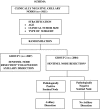Surgeon training, protocol compliance, and technical outcomes from breast cancer sentinel lymph node randomized trial
- PMID: 19704072
- PMCID: PMC2758311
- DOI: 10.1093/jnci/djp281
Surgeon training, protocol compliance, and technical outcomes from breast cancer sentinel lymph node randomized trial
Abstract
Background: The National Surgical Adjuvant Breast and Bowel Project B-32 trial was designed to determine whether sentinel lymph node resection can achieve the same therapeutic outcomes as axillary lymph node resection but with fewer side effects and is one of the most carefully controlled and monitored randomized trials in the field of surgical oncology. We evaluated the relationship of surgeon trial preparation, protocol compliance audit, and technical outcomes.
Methods: Preparation for this trial included a protocol manual, a site visit with key participants, an intraoperative session with the surgeon, and prerandomization documentation of protocol compliance. Training categories included surgeons who submitted material on five prerandomization surgeries and were trained by a core trainer (category 1) or by a site trainer (category 2). An expedited group (category 3) included surgeons with extensive experience who submitted material on one prerandomization surgery. At completion of training, surgeons could accrue patients. Two hundred twenty-four surgeons enrolled 4994 patients with breast cancer and were audited for 94 specific items in the following four categories: procedural, operative note, pathology report, and data entry. The relationship of training method; protocol compliance performance audit; and the technical outcomes of the sentinel lymph node resection rate, false-negative rate, and number of sentinel lymph nodes removed was determined. All statistical tests were two-sided.
Results: The overall sentinel lymph node resection success rate was 96.9% (95% confidence interval [CI] = 96.4% to 97.4%), and the overall false-negative rate was 9.5% (95% CI = 7.4% to 12.0%), with no statistical differences between training methods. Overall audit outcomes were excellent in all four categories. For all three training groups combined, a statistically significant positive association was observed between surgeons' average number of procedural errors and their false-negative rate (rho = +0.188, P = .021).
Conclusions: All three training methods resulted in uniform and high overall sentinel lymph node resection rates. Subgroup analyses identified some variation in false-negative rates that were related to audited outcome performance measures.
Figures
References
-
- Krag DN, Anderson SJ, Julian TB, et al. Technical outcomes of sentinel-lymph-node resection and conventional axillary-lymph-node dissection in patients with clinically node-negative breast cancer: results from the NSABP B-32 randomised phase III trial. Lancet Oncol. 2007;8(10):881–888. - PubMed
-
- Krag D, Weaver D, Ashikaga T, et al. The sentinel node in breast cancer—a multicenter validation study. N Engl J Med. 1998;339(14):941–946. - PubMed
-
- Harlow SP, Krag DN, Julian TB, et al. Prerandomization Surgical Training for the National Surgical Adjuvant Breast and Bowel Project (NSABP) B-32 trial: a randomized phase III clinical trial to compare sentinel node resection to conventional axillary dissection in clinically node-negative breast cancer. Ann Surg. 2005;241(1):48–54. - PMC - PubMed
-
- Practical Nonparametric Statistic. New York, NY: John Wiley & Sons; 1971.
-
- Begg C, Cho M, Eastwood S, et al. Improving the quality of reporting of randomized controlled trials. The CONSORT statement. JAMA. 1996;276(8):637–639. - PubMed
Publication types
MeSH terms
Grants and funding
LinkOut - more resources
Full Text Sources
Medical


